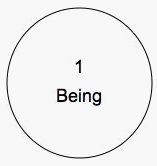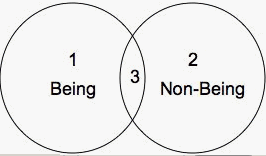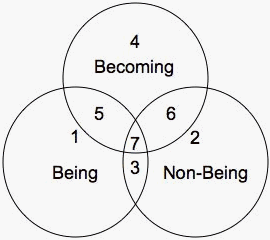Hegelian Logic - Down and Dirty
I am going to try to quickly explain an easier way to view the Hegelian dialectic. Consider this a cheat sheet of sorts. I will use the Carlson diagrams to aid in this... this method of analyzing Hegel was developed by Prof. David Carlson (a noted Hegelian commentator) and I've found them quite helpful in trying to help others wade through the Science of Logic. A collection of Carlson's works on Hegel can be found here. Remember though that these images are merely intended as aids, not as actual descriptions. That said, as the slaveboy in the Meno found out, the looks of something are always revealing.
This is the beginning of the Science of Logic. Just simple being. A momentary utterance of primordial existence. The simplest "is". The next moment shows what being reveals itself to be, non-being. Being exists only insofar as it is opposed to something, but that something is the very essence of the thing itself. Think life and death... what would life mean if we were immortal? Etc. Note also the similarity to Heraclitus here. For both Hegel and Heraclitus every thing "wants" its negation. It desires it the same way a man desire sexual gratification. The desire is fullfilled or marked by the conclusion of the sexual act. Being wants what it is, and what it is is non-being (its negation).
The next moment shows what being reveals itself to be, non-being. Being exists only insofar as it is opposed to something, but that something is the very essence of the thing itself. Think life and death... what would life mean if we were immortal? Etc. Note also the similarity to Heraclitus here. For both Hegel and Heraclitus every thing "wants" its negation. It desires it the same way a man desire sexual gratification. The desire is fullfilled or marked by the conclusion of the sexual act. Being wants what it is, and what it is is non-being (its negation).  The third moment of being/non-being is the sublative moment, the process of taking the middle term between the two and sublating it into a new, separate posited existence. That is, out of section 3, (the negation of the negation) a third entity will arise (non-being is the negation of being, vice versa, but section 3 is a unique substance as it comprises the negation of both). Another way to think of this is to simply allow being/non-being to transition back and forth repeatedly. Eventually a third moment is realized out of this transitioning... that third moment is where being and non-being resolve themselves, it is becoming.
The third moment of being/non-being is the sublative moment, the process of taking the middle term between the two and sublating it into a new, separate posited existence. That is, out of section 3, (the negation of the negation) a third entity will arise (non-being is the negation of being, vice versa, but section 3 is a unique substance as it comprises the negation of both). Another way to think of this is to simply allow being/non-being to transition back and forth repeatedly. Eventually a third moment is realized out of this transitioning... that third moment is where being and non-being resolve themselves, it is becoming.
This is as far as the simple dialectic will take us, a full and complete gordian knot (courtesy of Carlson of course). The next moment in the Logic is a speculative moment... not dissimilar from the movement from two to three circles, but somewhat more complicated.
The speculative moment can be right side or left side (in Carlsonian terms). That is, positive or negative, on the side of being or the side of non-being. At its disposal, reason has sections 4-7 to use as the basis for its posited new whole in the speculative moment. In other words, speculative reason will seize onto parts 4, 5, 6, or 7 (or a combination thereof) and posit a new whole. This the most crucial part of the Logic, what will becoming be? To find out, you'll have to read the Logic, or better yet, read some of Carlson's essays. For my purposes, this should serve as an ample introduction into Hegelian analysis.
This is the beginning of the Science of Logic. Just simple being. A momentary utterance of primordial existence. The simplest "is".
 The next moment shows what being reveals itself to be, non-being. Being exists only insofar as it is opposed to something, but that something is the very essence of the thing itself. Think life and death... what would life mean if we were immortal? Etc. Note also the similarity to Heraclitus here. For both Hegel and Heraclitus every thing "wants" its negation. It desires it the same way a man desire sexual gratification. The desire is fullfilled or marked by the conclusion of the sexual act. Being wants what it is, and what it is is non-being (its negation).
The next moment shows what being reveals itself to be, non-being. Being exists only insofar as it is opposed to something, but that something is the very essence of the thing itself. Think life and death... what would life mean if we were immortal? Etc. Note also the similarity to Heraclitus here. For both Hegel and Heraclitus every thing "wants" its negation. It desires it the same way a man desire sexual gratification. The desire is fullfilled or marked by the conclusion of the sexual act. Being wants what it is, and what it is is non-being (its negation).  The third moment of being/non-being is the sublative moment, the process of taking the middle term between the two and sublating it into a new, separate posited existence. That is, out of section 3, (the negation of the negation) a third entity will arise (non-being is the negation of being, vice versa, but section 3 is a unique substance as it comprises the negation of both). Another way to think of this is to simply allow being/non-being to transition back and forth repeatedly. Eventually a third moment is realized out of this transitioning... that third moment is where being and non-being resolve themselves, it is becoming.
The third moment of being/non-being is the sublative moment, the process of taking the middle term between the two and sublating it into a new, separate posited existence. That is, out of section 3, (the negation of the negation) a third entity will arise (non-being is the negation of being, vice versa, but section 3 is a unique substance as it comprises the negation of both). Another way to think of this is to simply allow being/non-being to transition back and forth repeatedly. Eventually a third moment is realized out of this transitioning... that third moment is where being and non-being resolve themselves, it is becoming.
This is as far as the simple dialectic will take us, a full and complete gordian knot (courtesy of Carlson of course). The next moment in the Logic is a speculative moment... not dissimilar from the movement from two to three circles, but somewhat more complicated.
The speculative moment can be right side or left side (in Carlsonian terms). That is, positive or negative, on the side of being or the side of non-being. At its disposal, reason has sections 4-7 to use as the basis for its posited new whole in the speculative moment. In other words, speculative reason will seize onto parts 4, 5, 6, or 7 (or a combination thereof) and posit a new whole. This the most crucial part of the Logic, what will becoming be? To find out, you'll have to read the Logic, or better yet, read some of Carlson's essays. For my purposes, this should serve as an ample introduction into Hegelian analysis.

<< Home